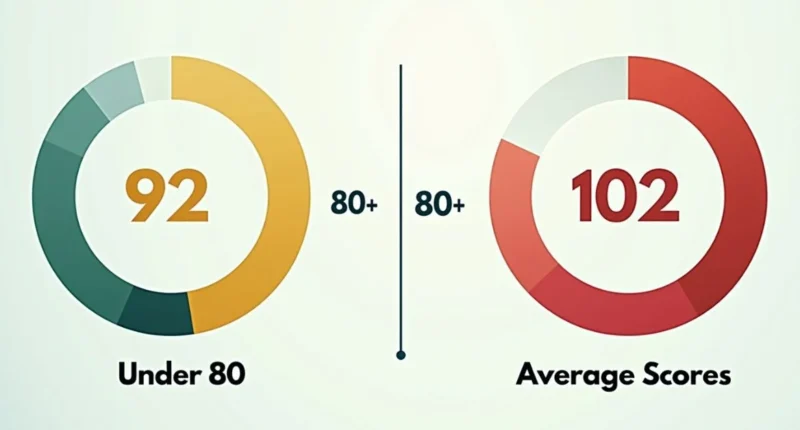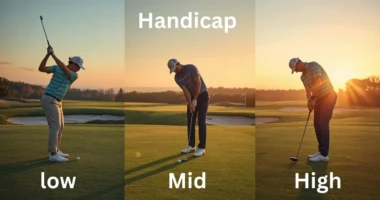Golf is one of those sports where numbers matter a lot, but at the same time, the “best” number depends on the player, the course, and experience. If you’re new to golf or have been playing for a while, you may have asked yourself: What is a good golf score?
The answer isn’t one-size-fits-all. A good golf score for a professional might be completely different from what counts as good for a weekend beginner.
Understanding Golf Scoring Basics
Before we decide what’s good, let’s understand how scoring in golf works.
- A golf course usually has 18 holes.
- Each hole has a “par” number. Par is the number of strokes (hits) an expert golfer is expected to take to complete that hole.
- Most courses have a par of 70, 71, or 72 in total.
Key Golf Score Terms:
- Par: Expected strokes to finish a hole.
- Birdie: 1 stroke under par.
- Eagle: 2 strokes under par.
- Bogey: 1 stroke over par.
- Double Bogey: 2 strokes over par.
So if a course is par 72, finishing with a score of 72 is excellent. That means you played “to par.” Anything below par (like 70 or 68) is even better.
What Is a Good Golf Score for Beginners?
For beginners, shooting 100 or fewer strokes on 18 holes is often considered a good score. Many new golfers start with scores well above 100. That’s completely normal because golf has a steep learning curve.
Here’s a guideline:
- 120+ strokes: New golfer, still learning.
- 100–110 strokes: Improving beginner.
- 90–100 strokes: Respectable score, shows solid progress.
So if you’re just starting and you manage to break 100, that’s an achievement worth celebrating!
What Is a Good Golf Score for Average Players?
For recreational golfers who play regularly, the target changes.
- Breaking 90 (scoring under 90) is often considered very good for the average golfer.
- Many weekend players score between 90–100 on average.
- An 85 on a par 72 course is usually seen as a strong round.
So if you’re not a pro but you want to know if your score is “good,” anything around 90 or less is something to be proud of.
What Is a Good Golf Score for Professionals?
For professional golfers, the standards are much higher.
- Par (72) or below is expected.
- Pros often shoot in the 60s (like 65, 68, or 69).
- During tournaments, even a few strokes over par might put a golfer out of contention.
For example, on the PGA Tour, average scores are often around 70–71 strokes per round. That’s a level most recreational players won’t reach, but it shows the difference between pro and casual golf.
Golf Score Benchmarks
To make it simple, here’s a table of what’s usually considered good at different levels:
- Beginner: Under 100
- Casual Golfer: Around 90
- Strong Amateur: 80–85
- Advanced / Low Handicap: 70–80
- Professional: Under 72
How to Improve Your Golf Score?
If you want to move from “okay” scores to “good” scores, here are some practical tips:
1. Improve Your Short Game
Most strokes are lost around the green. Practice putting, chipping, and pitching regularly.
2. Focus on Accuracy, Not Just Distance
Hitting the ball far is fun, but keeping it on the fairway saves more strokes than long drives into the rough.
3. Practice Consistently
Even short practice sessions a few times a week add up to big improvements over time.
4. Learn Course Strategy
Smart play, like laying up instead of risking water hazards, can lower your score.
5. Track Your Stats
Write down your number of putts, fairways hit, and greens in regulation. This will show where you need the most work.
6. Take Lessons
A coach can quickly fix mistakes in your swing or putting stroke that you might not notice yourself.
Factors That Affect Golf Scores
Not all golf rounds are equal. Many things affect whether a score is “good” or not:
- Course Difficulty: Some courses are easier, others are extremely tough.
- Weather Conditions: Wind, rain, or heat can change your performance.
- Tee Placement: Playing from championship tees makes the course longer and harder.
- Experience Level: A “good” score for a beginner might not be the same for a seasoned golfer.
So, always consider the context when judging your score.
How Golf Handicaps Relate to Good Scores?
Scores are often discussed in conjunction with handicaps, which measure a player’s skill. Your good golf handicap shows how many strokes over par you typically shoot, and it helps explain what’s considered a good score for you.
For example:
- A 20-handicap golfer might typically score around 92 on a par 72 course.
- A 10-handicap golfer often shoots in the low 80s.
- A scratch golfer (0 handicap) usually plays around par (72).
So, a “good” golf score isn’t the same for everyone; it’s close to or better than what your handicap suggests. Tracking both your scores and handicap will give you the clearest picture of improvement.
Conclusion
So, what is a good golf score?
- For beginners: 100 or below is great.
- For casual golfers: breaking 90 is a strong goal.
- For advanced players: 70s and low 80s show real skill.
- For professionals: par or below is expected.
A “good” golf score shows you are improving and still having fun. Whether you’re aiming to break 100 for the first time or pushing into the 70s, every step forward is worth celebrating.





